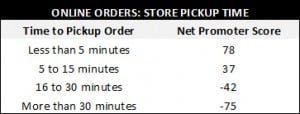‘Tis the season to deliver a standout omnichannel experience for shoppers. And if you don’t, well, bah humbug on your sales figures – because consumers today demand a seamless online-offline shopping experience.
Smart retailers have been preparing for Holiday 2013 for months, putting new omnichannel shopping experiences in place to entice customers to their sites and stores. Done right, online-offline initiatives – such as in-store pickup, mobile apps, and in-store kiosks – herald a rebirth of retail. But done badly, omnichannel programs alienate shoppers and damage your brand.
In-store pickup is one omnichannel feature that can go amazingly well – or frightfully wrong – depending on how you execute. Fighting back against the much-hyped threats of showrooming and same-day delivery, many omnichannel retailers now let customers buy or reserve products online, and then pick them up in-store. Whether consumers retrieve goods at a special counter, in the checkout line, or from a locker, in-store fulfillment has proved extremely popular among shoppers. That’s because it combines the best of both worlds: the convenience of online or mobile shopping and the immediate satisfaction of in-store purchases.
For retailers, in-store fulfillment also offers clear advantages. Turning your store into a vibrant local fulfillment center not only encourages more online purchases, it brings customers in-store, where they’ll often throw a few extra items in the cart. According to Forrester Research, one-third of consumers who use in-store pickup end up buying additional products when in the store.
But here’s the rub; in-store pickup only works if the process is glitch-free. From the standpoint of execution, it can go wrong quickly – turning off shoppers and negatively impacting the retailer’s brand. Customers want to easily find the pick-up location, get efficient and friendly customer service, and avoid long lines. If customers have the opposite experience, they’ll not only never use in-store pickup again, but may never shop with that retailer again!
New data from OpinionLab Customer Feedback Index shows that it only takes about 15 minutes for an in-store pickup to go wrong – and 30 minutes to turn into a customer experience nightmare. The bottom line: when folks buy online and choose the store pickup option, they want to get in and out of the store quickly. The longer they wait, the more their shopping experience turns into a Nightmare Before Christmas – and the more their future loyalty takes a nosedive. Shoppers waiting around get angry, and that provides a negative spectacle to other shoppers. (“I’m never using that service!”)
 So, as a retailer, how can you execute omnichannel initiatives flawlessly this holiday? The answer is pretty simple: listen to your customers, learn from them, and evolve.
So, as a retailer, how can you execute omnichannel initiatives flawlessly this holiday? The answer is pretty simple: listen to your customers, learn from them, and evolve.
Give your customers plenty of opportunities to share their feedback however, whenever and wherever they chose. Then, once you have this feedback, respond to it. If customers are unhappy with any part of the in-store fulfillment experience, reach out to them right away to thank them for the feedback and offer to fix the problem. In the case of in-store fulfillment for example, if customers mostly complain that lines are too long, open more counters. You get the picture; identify what’s broken, fix it, and do it quickly.
The added bonus of collecting customer feedback is that it can be used to improve other aspects of the customer experience (beyond the problem you were hoping to solve). Through feedback, retailers can spot patterns in shoppers’ purchases, product preferences, and behaviors – and find ways to build deeper engagement online and off.
It’s hard to get omnichannel innovation right straight out of the gate. For example, mobile and tablet shopping were all the rage for retailers last holiday. As I’ve covered before, retailers did a great job of rolling out tablet experiences, but fell short when it came to checkout. According to our research, shoppers ranked the tablet browsing experience 3.64 out of 5, compared to just 2.94 out of 5 for browsing on desktops, but reported the lowest experience scores, compared to smartphone and desktop, when it came to completing a purchase. This holiday, I expect retailers will have made great strides in fixing this disconnect.
When done right, omnichannel initiatives increase customer acquisition, boosts customer engagement, and generates sales. When they go wrong, however, they alienate customers and hurt your brand. Incorporating feedback loops into your omnichannel initiatives will ensure you identify and fix problems right away, so your holiday innovations keep giving all the year through.
Jonathan Levitt is Chief Marketing Officer at OpinionLab.